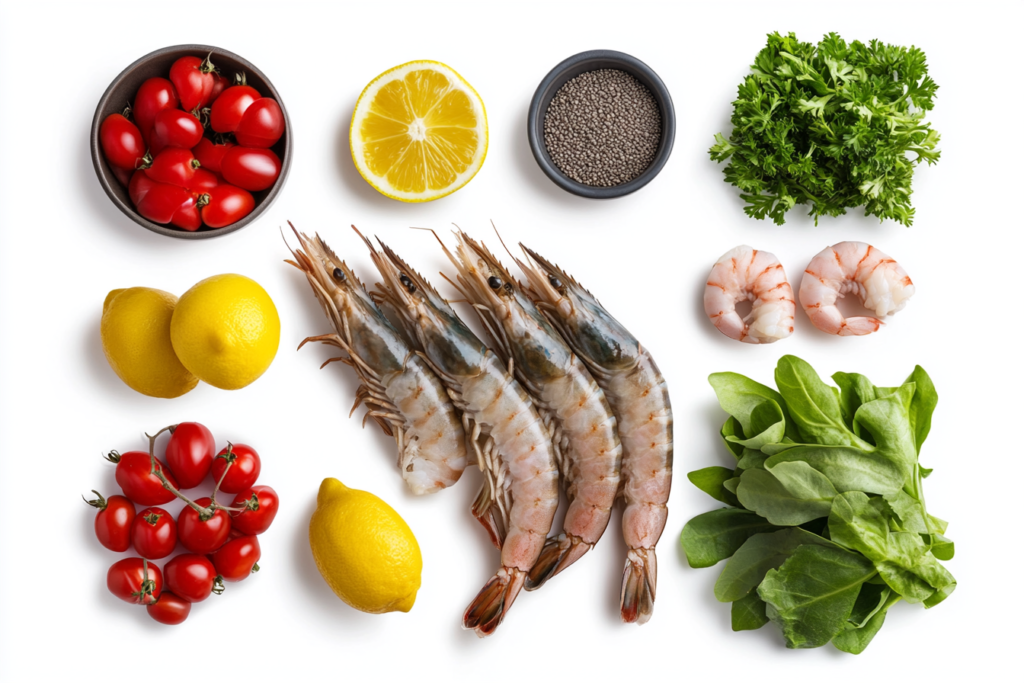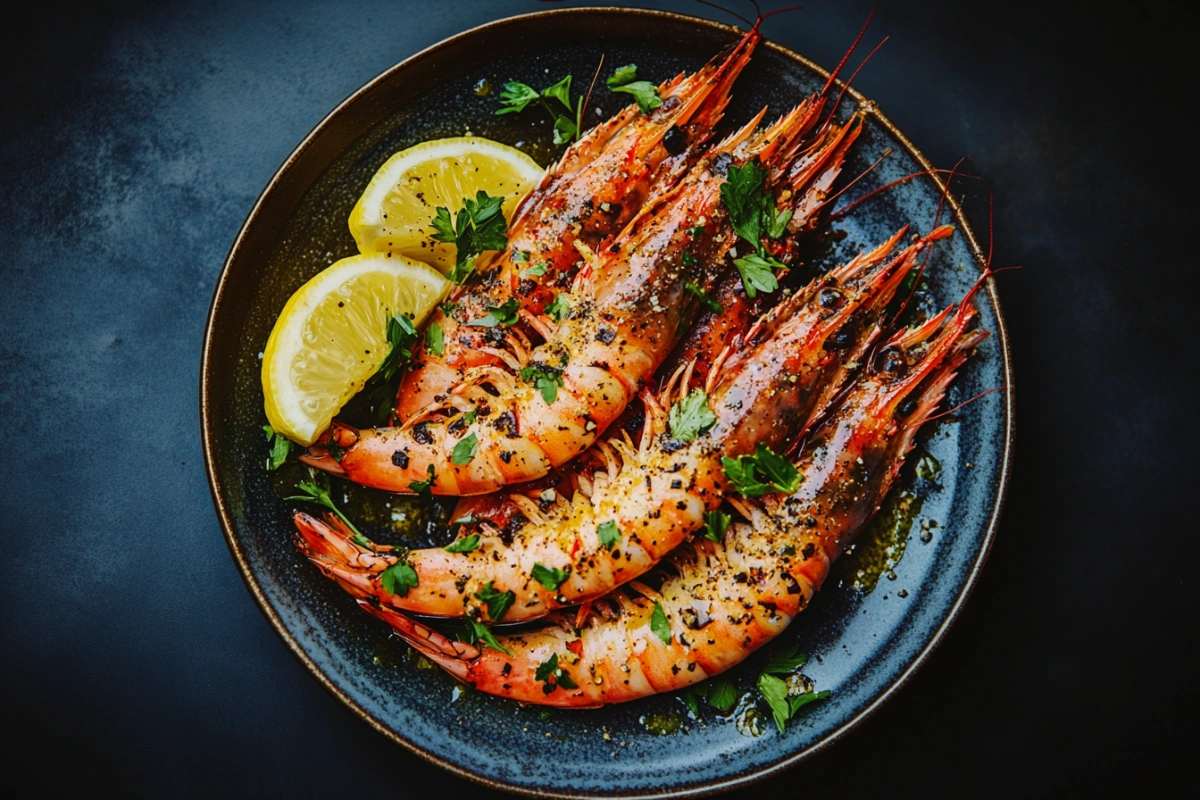Tiger shrimp are a seafood delicacy prized for their sweet, nutty flavor and impressive size. Whether you’re a professional chef or a home cook, mastering how to choose, store, and cook these flavorful crustaceans can make all the difference in your seafood dishes.
In this guide, you’ll explore everything you need to know about jumbo shrimp, including their origin, health benefits, buying tips, storage methods, and the best ways to prepare them. Each section is crafted to help you become an expert, from the basics to pro-level cooking tips.
Introduction to Tiger Shrimp
What Are jumbo shrimp?
Tiger shrimp (Penaeus monodon), also called giant tiger prawns, are a species of large, striped shrimp known for their bold, sweet flavor and firm texture. Native to the Indo-Pacific region, these crustaceans have become a global seafood favorite, especially in Asian and Mediterranean cuisine.
Their distinct black stripes across their grayish shells give them the name tjumbo shrimp. When cooked, they turn a beautiful pinkish-white color, making them visually striking on a plate.
These shrimp are highly versatile in the kitchen. Whether you’re grilling, boiling, or stir-frying, their firm flesh holds up well to different cooking methods. They’re often preferred in pasta dishes, seafood platters, and even sushi rolls.
Tiger Shrimp vs. Black Tiger Prawns: Key Differences
Although the terms tiger shrimp and black tiger prawns are often used interchangeably, they refer to slightly different crustaceans:
- Size & Appearance: Black tiger prawns tend to grow slightly larger with darker, bolder stripes.
- Texture: Tiger shrimp have a firmer bite, while black tiger prawns offer a slightly softer texture.
- Taste: Both are sweet and buttery, but tjumbo shrimp often have a more pronounced oceanic flavor.
- Culinary Use: Both can be cooked similarly—grilled, broiled, or sautéed.
Whether you choose tiger shrimp or black tiger prawns, both are excellent options for seafood lovers.
Habitat and Origin
Natural Habitat of jumbo shrimp
Tiger shrimp thrive in the warm, shallow waters of the Indo-Pacific region, especially along the coasts of India, Thailand, and Vietnam. These crustaceans prefer brackish waters—part saltwater, part freshwater—making estuaries and mangrove swamps their ideal homes.
Their natural habitat contributes to their distinct flavor, often described as sweet with a mild oceanic taste. Since jumbo shrimp are bottom dwellers, they often burrow into the sandy or muddy seafloor, feeding on small marine plants and organic matter.
Farming Regions and Sustainability Practices
Due to high demand, jumbo shrimp are commonly farmed in regions like Southeast Asia and parts of Central America. Farming has made these shrimp more accessible, but it also raises sustainability concerns.
To address environmental issues, some farms have shifted to eco-friendly aquaculture practices such as:
- Using recirculating aquaculture systems (RAS) to reduce water pollution.
- Practicing mangrove restoration where shrimp farms have disrupted natural habitats.
Look for certifications like ASC (Aquaculture Stewardship Council) or Best Aquaculture Practices (BAP) when purchasing to support responsible farming.
Nutritional Value and Health Benefits

Macronutrients in Tiger Shrimp
Tiger shrimp pack a punch when it comes to lean protein, making them a favorite for health-conscious eaters. A standard 100-gram serving provides:
- Protein: 20-22g of high-quality protein
- Calories: Approximately 85-100 kcal
- Fat: Less than 1g (mostly healthy omega-3 fats)
They’re also low in carbohydrates and perfect for low-carb or keto diets.
Health Benefits: Low-Calorie Protein Source
Tiger shrimp aren’t just delicious—they’re also a nutritional powerhouse! Some top health benefits include:
- Muscle Maintenance: The high protein content helps build and repair muscle.
- Heart Health: Omega-3 fatty acids support cardiovascular health.
- Weight Loss Friendly: With low fat and minimal calories, they make a filling yet light meal.
Plus, they’re rich in selenium, vitamin B12, and zinc, which boost immunity and promote healthy skin.
Nutritional Value of Tiger Shrimp (Per 100g)
jumbo shrimp are not just delicious—they’re also packed with essential nutrients, making them a healthy choice for seafood lovers. Here’s a breakdown of the nutritional content per 100g of raw tiger shrimp:
| Nutrient | Amount (per 100g) |
|---|---|
| Calories | 99 kcal |
| Protein | 20g |
| Total Fat | 1g |
| Saturated Fat | 0.2g |
| Cholesterol | 152mg |
| Carbohydrates | 0g |
| Omega-3 Fatty Acids | 0.3g |
| Sodium | 111mg |
| Vitamin B12 | 1.2µg (50% DV) |
| Selenium | 54µg (98% DV) |
Buying Tiger Shrimp
How to Choose Fresh Tiger Shrimp
Selecting fresh tiger shrimp can make a world of difference in taste and texture. When shopping, here’s what to check:
- Shell Appearance: Opt for shrimp with firm, glossy shells. Avoid slimy or cracked shells.
- Color: Raw jumbo shrimp are typically gray with dark stripes. Avoid shrimp with black spots, which could indicate spoilage.
- Smell: Fresh shrimp should have a mild oceanic scent, not an ammonia or overly fishy smell.
- Size Matters: Shrimp are often labeled by size (e.g., 8-12 count per pound). The lower the count, the larger the shrimp.
Choosing high-quality shrimp ensures better texture and flavor when cooked.
Best Online Sources for Tiger Shrimp
If you can’t find fresh tiger shrimp locally, online seafood retailers offer great options. Some top sources include:
- Alaska King Crab Company: Offers wild-caught jumbo shrimp, shipped overnight.
- Rastelli’s Seafood: Provides sustainably sourced, antibiotic-free shrimp.
- Great Alaska Seafood: Offers farmed shrimp from Indonesia with overnight shipping.
For the best experience, look for suppliers offering flash-frozen shrimp, which retain freshness during shipping.
Storing and Handling jumbo shrimp
Proper Storage Techniques for Fresh Tiger Shrimp
To keep your tiger shrimp tasting their best, proper storage is crucial. Here’s how to do it:
- Refrigerate: Store raw shrimp in a sealed container filled with ice in the coldest part of the fridge.
- Use Quickly: Consume within 1-2 days for optimal freshness.
- Freeze Properly: If not using soon, freeze shrimp in airtight bags, removing as much air as possible.
How to Freeze and Thaw jumbo shrimp
Freezing shrimp correctly helps preserve their sweet flavor. To freeze:
- Pat the shrimp dry.
- Place them in a freezer bag with minimal air.
- Store for up to 3 months.
When ready to cook, thaw shrimp by:
- Placing them in the fridge for 6-8 hours.
- Running cold water over the shrimp for a quicker method.
Avoid using hot water, as it can lead to uneven thawing and affect texture.
Cooking Tiger Shrimp
Best Cooking Methods: Grilling, Boiling, Stir-Frying

jumbo shrimp are incredibly versatile in the kitchen. Their firm texture and sweet flavor hold up well in various cooking methods:
- Grilling: Brush the shrimp with olive oil, season lightly, and grill over medium heat for 2-3 minutes per side. Grilling enhances their smoky sweetness.
- Boiling: Bring a pot of salted water to a rolling boil. Add the jumbo shrimp and cook for 2-3 minutes until pink and opaque. Perfect for shrimp cocktails!
- Stir-Frying: For a quick, flavorful dish, toss the shrimp in a hot pan with garlic, ginger, and soy sauce for 3-4 minutes.
Pro Tip: Avoid overcooking! Shrimp turn rubbery if cooked too long. Aim for a bright pink hue and slight curl.
Top Recipes Featuring jumbo shrimp
Looking for inspiration? Here are some delicious ttiger prawns recipes you can try:
- Garlic Butter Tiger Shrimp: Saute jumbo shrimp in butter, garlic, and parsley for a quick yet elegant dish.
- Tiger Shrimp Scampi: Cook shrimp in a white wine and lemon butter sauce, served over pasta.
- Spicy Tiger Shrimp Tacos: Toss shrimp in Cajun seasoning, grill them, and serve in corn tortillas with slaw.
The sweet, nutty taste of jumbo shrimp makes them ideal for both simple and gourmet recipes.
Taste and Culinary Uses
Flavor Profile of Tiger Shrimp
Tiger shrimp boast a sweet, mild oceanic flavor with a buttery finish. Their firm flesh gives a satisfying bite, making them a favorite in many cuisines.
When cooked, they develop a slightly nutty undertone, which pairs beautifully with citrus, garlic, and spicy flavors.
Popular Dishes Featuring tiger prawns
Thanks to their impressive size and delicate sweetness, tiger shrimp shine in numerous global dishes:
- Asian Cuisine: Used in Thai curries, Vietnamese spring rolls, and Japanese tempura.
- Mediterranean Dishes: Often served grilled with lemon and herbs or in seafood paellas.
- American Favorites: Think shrimp cocktail, scampi, and jambalaya.
Tiger shrimp are perfect for grilling, searing, or even enjoying chilled in seafood platters. Their versatile taste works with various herbs, spices, and sauces, making them a kitchen superstar.
Tiger Shrimp in the Seafood Industry
Export Markets and Demand Trends
Tiger shrimp have become a global seafood favorite, with demand surging in both local markets and international trade. Countries like Thailand, Vietnam, and India lead in both wild-caught and farmed tiger prawns exports.
The United States, European Union, and Japan rank among the top importers due to the shrimp’s impressive size and sweet, firm texture. As global seafood consumption rises, jumbo shrimp have carved a niche in both luxury dining and everyday meals.
However, consumer preferences are shifting. More people are seeking sustainably sourced tiger shrimp, pushing suppliers to adopt eco-friendly practices.
Role of tiger prawns in Global Cuisine
Tiger shrimp play a key role in diverse culinary traditions worldwide. Their mild, sweet taste makes them a versatile protein in many iconic dishes.
- Asian Cuisine: Often featured in Thai curries, Vietnamese spring rolls, and Chinese stir-fries.
- Mediterranean Fare: Commonly grilled with lemon, garlic, and fresh herbs.
- American Seafood Classics: Think shrimp cocktails, scampi, and seafood boils.
Their large size and striking stripes also make them visually appealing in premium seafood presentations. Whether used in casual barbecues or gourmet dishes, jumbo shrimp shrimp continue to impress food enthusiasts worldwide.
Environmental Impact and Sustainability
Environmental Concerns in tiger prawns Farming
While tiger shrimp farming has made these crustaceans more accessible, it has raised some environmental challenges. Intensive farming practices can lead to:
- Habitat Destruction: Mangrove deforestation disrupts natural ecosystems.
- Water Pollution: Waste and chemical runoff from shrimp farms can pollute nearby waters.
- Overfishing: Wild jumbo shrimp harvesting sometimes strains natural populations.
These issues have sparked concerns about the long-term sustainability of the industry.
Sustainable Farming Practices and Certifications
Thankfully, the seafood industry is evolving. Many producers now focus on sustainable aquaculture practices to reduce harm and ensure jumbo shrimp remain available for future generations.
Key sustainable practices include:
- Eco-Friendly Farms: Using recirculating aquaculture systems to minimize pollution.
- Habitat Restoration: Replanting mangroves near farming sites.
- Certifications: Look for labels like ASC (Aquaculture Stewardship Council) and BAP (Best Aquaculture Practices) when buying shrimp.
By choosing responsibly farmed tiger shrimp, you can support ethical sourcing while enjoying delicious seafood.

